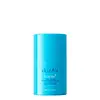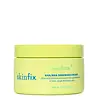What's inside
What's inside
 Key Ingredients
Key Ingredients

 Benefits
Benefits

 Concerns
Concerns

 Ingredients Side-by-side
Ingredients Side-by-side

Water
Skin ConditioningGlycerin
HumectantCaprylic/Capric Triglyceride
MaskingRicinus Communis Seed Oil
MaskingCetearyl Alcohol
EmollientJojoba Oil/Macadamia Seed Oil Esters
Skin ConditioningSolanum Tuberosum Pulp Extract
SmoothingBehenyl Alcohol
EmollientPropanediol
SolventHelianthus Annuus Seed Oil
EmollientEctoin
Skin ConditioningTocopherol
AntioxidantAllantoin
Skin ConditioningSqualene
EmollientFurcellaria Lumbricalis Extract
Skin ConditioningMomordica Charantia Fruit Extract
Skin ConditioningAmylopectin
Arnica Montana Flower Extract
MaskingAcetyl Glutamine
Skin ConditioningLecithin
EmollientPhytosteryl Macadamiate
Skin ConditioningPhospholipids
Skin ConditioningBeta-Glucan
Skin ConditioningLactobacillus Ferment
Skin ConditioningLithothamnion Calcareum Extract
Skin ConditioningBacillus/Soybean Ferment Extract
Skin ConditioningHexapeptide-11
Skin ConditioningOligopeptide-1
Skin ConditioningOligopeptide-2
Skin ConditioningOligopeptide-3
Skin ConditioningFolic Acid
Skin ConditioningSodium Hyaluronate
HumectantLactic Acid
BufferingPhytosterols
Skin ConditioningCeramide NP
Skin ConditioningPhytosphingosine
Skin ConditioningCeramide AP
Skin ConditioningCholesterol
EmollientCeramide EOP
Skin ConditioningCetearyl Glucoside
EmulsifyingPentylene Glycol
Skin ConditioningEthylhexylglycerin
Skin ConditioningPotassium Sorbate
PreservativeCaprylyl Glycol
EmollientSodium Benzoate
MaskingSodium Lauroyl Lactylate
EmulsifyingXanthan Gum
EmulsifyingCarbomer
Emulsion StabilisingCitric Acid
BufferingSodium Hydroxide
BufferingPhenoxyethanol
PreservativeWater, Glycerin, Caprylic/Capric Triglyceride, Ricinus Communis Seed Oil, Cetearyl Alcohol, Jojoba Oil/Macadamia Seed Oil Esters, Solanum Tuberosum Pulp Extract, Behenyl Alcohol, Propanediol, Helianthus Annuus Seed Oil, Ectoin, Tocopherol, Allantoin, Squalene, Furcellaria Lumbricalis Extract, Momordica Charantia Fruit Extract, Amylopectin, Arnica Montana Flower Extract, Acetyl Glutamine, Lecithin, Phytosteryl Macadamiate, Phospholipids, Beta-Glucan, Lactobacillus Ferment, Lithothamnion Calcareum Extract, Bacillus/Soybean Ferment Extract, Hexapeptide-11, Oligopeptide-1, Oligopeptide-2, Oligopeptide-3, Folic Acid, Sodium Hyaluronate, Lactic Acid, Phytosterols, Ceramide NP, Phytosphingosine, Ceramide AP, Cholesterol, Ceramide EOP, Cetearyl Glucoside, Pentylene Glycol, Ethylhexylglycerin, Potassium Sorbate, Caprylyl Glycol, Sodium Benzoate, Sodium Lauroyl Lactylate, Xanthan Gum, Carbomer, Citric Acid, Sodium Hydroxide, Phenoxyethanol
Water
Skin ConditioningCocos Nucifera Oil
MaskingCaprylic/Capric Triglyceride
MaskingStearyl Alcohol
EmollientPolyglyceryl-2 Stearate
EmulsifyingGlycerin
HumectantOlus Oil
EmollientButyrospermum Parkii Butter
Skin ConditioningCaprylyl Caprylate/Caprate
EmollientPropanediol
SolventGlyceryl Stearate
EmollientVaccinium Myrtillus Fruit Extract
Skin ConditioningBetaine
HumectantMicrocitrus Australasica Fruit Extract
Saccharum Officinarum Extract
MoisturisingCitrus Aurantium Dulcis Fruit Extract
MaskingCitrus Limon Fruit Extract
MaskingSalix Nigra Bark Extract
Skin ProtectingHelianthus Annuus Extract
EmollientPrunus Amygdalus Dulcis Oil
Skin ConditioningAcer Saccharum Extract
Skin ConditioningRosmarinus Officinalis Leaf Extract
AntimicrobialSimmondsia Chinensis Seed Oil
EmollientVitis Vinifera Seed Oil
EmollientTrisodium Ethylenediamine Disuccinate
Aloe Barbadensis Leaf Juice
Skin ConditioningOryza Sativa Bran Extract
Skin ConditioningPanthenol
Skin ConditioningTocopherol
AntioxidantAllantoin
Skin ConditioningXanthan Gum
EmulsifyingBisabolol
MaskingEthylhexylglycerin
Skin ConditioningSodium Hydroxide
BufferingPhenoxyethanol
PreservativePotassium Sorbate
PreservativeCitric Acid
BufferingWater, Cocos Nucifera Oil, Caprylic/Capric Triglyceride, Stearyl Alcohol, Polyglyceryl-2 Stearate, Glycerin, Olus Oil, Butyrospermum Parkii Butter, Caprylyl Caprylate/Caprate, Propanediol, Glyceryl Stearate, Vaccinium Myrtillus Fruit Extract, Betaine, Microcitrus Australasica Fruit Extract, Saccharum Officinarum Extract, Citrus Aurantium Dulcis Fruit Extract, Citrus Limon Fruit Extract, Salix Nigra Bark Extract, Helianthus Annuus Extract, Prunus Amygdalus Dulcis Oil, Acer Saccharum Extract, Rosmarinus Officinalis Leaf Extract, Simmondsia Chinensis Seed Oil, Vitis Vinifera Seed Oil, Trisodium Ethylenediamine Disuccinate, Aloe Barbadensis Leaf Juice, Oryza Sativa Bran Extract, Panthenol, Tocopherol, Allantoin, Xanthan Gum, Bisabolol, Ethylhexylglycerin, Sodium Hydroxide, Phenoxyethanol, Potassium Sorbate, Citric Acid
Ingredients Explained
These ingredients are found in both products.
Ingredients higher up in an ingredient list are typically present in a larger amount.
Allantoin is a soothing ingredient known for its protective and moisturizingg properties. Because of this, it is often added to products with strong active ingredients.
Studies show higher concentrations of this ingredient can promote wound healing.
Though it can be derived from the comfrey plant, allantoin is produced synthetically for cosmetic products to ensure purity.
Learn more about AllantoinThis ingredient is an emollient, solvent, and texture enhancer. It is considered a skin-softener by helping the skin prevent moisture loss.
It helps thicken a product's formula and makes it easier to spread by dissolving clumping compounds.
Caprylic Triglyceride is made by combining glycerin with coconut oil, forming a clear liquid.
While there is an assumption Caprylic Triglyceride can clog pores due to it being derived from coconut oil, there is no research supporting this.
Learn more about Caprylic/Capric TriglycerideCitric Acid is an alpha hydroxy acid (AHA) naturally found in citrus fruits like oranges, lemons, and limes.
Like other AHAs, citric acid can exfoliate skin by breaking down the bonds that hold dead skin cells together. This helps reveal smoother and brighter skin underneath.
However, this exfoliating effect only happens at high concentrations (20%) which can be hard to find in cosmetic products.
Due to this, citric acid is usually included in small amounts as a pH adjuster. This helps keep products slightly more acidic and compatible with skin's natural pH.
In skincare formulas, citric acid can:
While it can provide some skin benefits, research shows lactic acid and glycolic acid are generally more effective and less irritating exfoliants.
Most citric acid used in skincare today is made by fermenting sugars (usually from molasses). This synthetic version is identical to the natural citrus form but easier to stabilize and use in formulations.
Read more about some other popular AHA's here:
Learn more about Citric AcidEthylhexylglycerin (we can't pronounce this either) is commonly used as a preservative and skin softener. It is derived from glyceryl.
You might see Ethylhexylglycerin often paired with other preservatives such as phenoxyethanol. Ethylhexylglycerin has been found to increase the effectiveness of these other preservatives.
Glycerin is already naturally found in your skin. It helps moisturize and protect your skin.
A study from 2016 found glycerin to be more effective as a humectant than AHAs and hyaluronic acid.
As a humectant, it helps the skin stay hydrated by pulling moisture to your skin. The low molecular weight of glycerin allows it to pull moisture into the deeper layers of your skin.
Hydrated skin improves your skin barrier; Your skin barrier helps protect against irritants and bacteria.
Glycerin has also been found to have antimicrobial and antiviral properties. Due to these properties, glycerin is often used in wound and burn treatments.
In cosmetics, glycerin is usually derived from plants such as soybean or palm. However, it can also be sourced from animals, such as tallow or animal fat.
This ingredient is organic, colorless, odorless, and non-toxic.
Glycerin is the name for this ingredient in American English. British English uses Glycerol/Glycerine.
Learn more about GlycerinPhenoxyethanol is a preservative that has germicide, antimicrobial, and aromatic properties. Studies show that phenoxyethanol can prevent microbial growth. By itself, it has a scent that is similar to that of a rose.
It's often used in formulations along with Caprylyl Glycol to preserve the shelf life of products.
Potassium Sorbate is a preservative used to prevent yeast and mold in products. It is commonly found in both cosmetic and food products.
This ingredient comes from potassium salt derived from sorbic acid. Sorbic acid is a natural antibiotic and effective against fungus.
Both potassium sorbate and sorbic acid can be found in baked goods, cheeses, dried meats, dried fruit, ice cream, pickles, wine, yogurt, and more.
You'll often find this ingredient used with other preservatives.
Learn more about Potassium SorbatePropanediol is an all-star ingredient. It softens, hydrates, and smooths the skin.
It’s often used to:
Propanediol is not likely to cause sensitivity and considered safe to use. It is derived from corn or petroleum with a clear color and no scent.
Learn more about PropanediolSodium Hydroxide is also known as lye or caustic soda. It is used to adjust the pH of products; many ingredients require a specific pH to be effective.
In small amounts, sodium hydroxide is considered safe to use. However, large amounts may cause chemical burns due to its high alkaline.
Your skin has a natural pH and acid mantle. This acid mantle helps prevent harmful bacteria from breaking through. The acid mantle also helps keep your skin hydrated.
"Alkaline" refers to a high pH level. A low pH level would be considered acidic.
Learn more about Sodium HydroxideTocopherol (also known as Vitamin E) is a common antioxidant used to help protect the skin from free-radicals and strengthen the skin barrier. It's also fat soluble - this means our skin is great at absorbing it.
Vitamin E also helps keep your natural skin lipids healthy. Your lipid skin barrier naturally consists of lipids, ceramides, and fatty acids. Vitamin E offers extra protection for your skin’s lipid barrier, keeping your skin healthy and nourished.
Another benefit is a bit of UV protection. Vitamin E helps reduce the damage caused by UVB rays. (It should not replace your sunscreen). Combining it with Vitamin C can decrease sunburned cells and hyperpigmentation after UV exposure.
You might have noticed Vitamin E + C often paired together. This is because it is great at stabilizing Vitamin C. Using the two together helps increase the effectiveness of both ingredients.
There are often claims that Vitamin E can reduce/prevent scarring, but these claims haven't been confirmed by scientific research.
Learn more about TocopherolWater. It's the most common cosmetic ingredient of all. You'll usually see it at the top of ingredient lists, meaning that it makes up the largest part of the product.
So why is it so popular? Water most often acts as a solvent - this means that it helps dissolve other ingredients into the formulation.
You'll also recognize water as that liquid we all need to stay alive. If you see this, drink a glass of water. Stay hydrated!
Learn more about WaterXanthan gum is used as a stabilizer and thickener within cosmetic products. It helps give products a sticky, thick feeling - preventing them from being too runny.
On the technical side of things, xanthan gum is a polysaccharide - a combination consisting of multiple sugar molecules bonded together.
Xanthan gum is a pretty common and great ingredient. It is a natural, non-toxic, non-irritating ingredient that is also commonly used in food products.
Learn more about Xanthan Gum